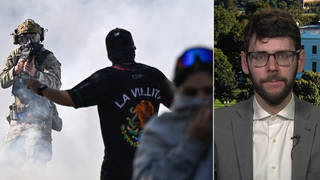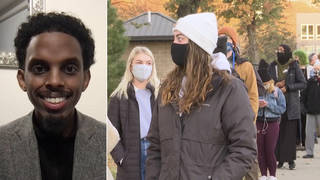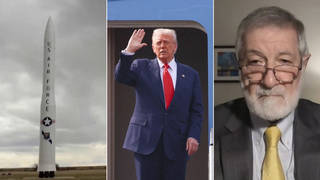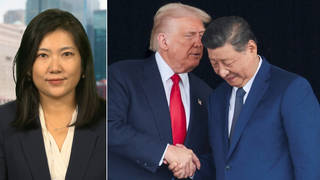
Some pundits predict that the winner of the 2004 presidential election could potentially fill 2 to 3 vacancies on the Supreme Court, which could have a major impact on abortion, affirmative actions, gay marriage and much more. We speak with National Journal columnist Stuart Taylor Jr. [includes rush transcript]
This is Democracy Now!'s special coverage “Countdown to the Showdown: The Battle for the White House. Six days until the election. It may not be the October surprise that has been speculated on for months now, but the hospitalization earlier this week of Chief Justice William Rehnquist for cancer has brought the issue of the next president's power to mold the court to front and center in the race for the White House. Even before his thyroid cancer diagnosis, most believed the 80-year-old would step down in the next presidential term. Rehnquist has been the court’s conservative anchor for a generation. Some analysts predict that the next president could potentially fill 2 to 3 vacancies on the court. In addition to the health of the 80 year-old Rehnquist, Liberal Justice John Paul Stevens is 84 years old, Justice Sandra Day O’Connor is 74 and 5 of the 6 other justices are over 65. The appointments in the next presidency could have a major impact over such issues as Roe v Wade, affirmative action, gay marriage and other significant domestic issues.
As it stands now, the court is weighted with more conservatives than liberals–but barely. Many of the closest cases, like the 2000 Bush v. Gore decision that gave Bush the presidency, are decided on 5-4 votes. If Bush wins, and Republicans keep their narrow control of the Senate, a Rehnquist retirement would give Bush the opportunity to promote a sitting justice to chief justice, and put a new face on the court.
- Stuart Taylor Jr., columnist at the National Journal and contributor to Newsweek.
Transcript
AMY GOODMAN: We’re joined now by Stuart Taylor, he’s a columnist at The National Journal, and contributor to Newsweek. Welcome to Democracy Now!.
STUART TAYLOR, JR.: Thanks for having me.
AMY GOODMAN: It’s good to have you with us. Well, can you describe right now the situation of the court with the Chief Justice Rehnquist now being sick?
STUART TAYLOR, JR.: Yes. I think it is — does raise the potential if he retires for health reasons of a dramatic shift in the court’s — in the court’s direction only if John Kerry replaces him. Because if President Bush replaces him, he will be presumably trading a conservative for a conservative, no matter whether he elevates someone else to Chief Justice or appoints someone from outside the court as Chief Justice. It would be a conservative for conservative. If, on the other hand, a President Kerry replaced Rehnquist or tried to replace him with someone whose voting pattern would be expected to be like that of Clinton nominees, Ruth Bader Ginsburg and Stephen Breyer, that would raise the potential for a dramatic shift in the direction of the law on a variety of issues, particularly religion and the state, and the republicans in the Senate, knowing that, would probably mount a titanic confirmation battle to try and prevent that. I think it’s doubtful whether a nominee seen as liberal could get through under those circumstances. It’s also doubtful that a nominee seen as conservative, if President Bush wins, could get through to replace John Paul Stevens, for example, who is 84, and the Court’s most liberal member.
AMY GOODMAN: Can you talk about the different Supreme Court Justices, like Sandra Day O’Connor? It was reputed or reported before during the earlier contest for president that President Bush, when he was chosen by the Supreme Court, that she had said at a party she was waiting to make sure that President Bush would be able to appoint a replacement for her, yet she did not retire in this four years.
STUART TAYLOR, JR.: No, she didn’t. I wasn’t surprised that she didn’t. I think it was actually her husband who was reported to have said something along those lines at a party, but that was hearsay and I think these Justices like their jobs. They have great power. She’s the most powerful woman in the country, arguably, because as the — sort of the Justice right in the middle of the court whenever there’s a big 5-4 decision where liberals and conservatives divide, the result tends to be whatever she wants it to be, because she can give either side a majority. They have enormous status. They don’t — they get nice three or four month summer vacations. They go to Europe and hobnob with other justices, and I think that it’s much more important to them as long as they’re healthy, to keep doing what they like to do, and to try and kind of engineer who replaces them.
AMY GOODMAN: So, let’s talk about some of the key issues — separation of church and state, Roe v. Wade, affirmative action — and what you think will happen.
STUART TAYLOR, JR.: Again, it depends on who is replacing whom. The status quo is on abortion rights, there are six of the current justices have voted to reaffirm Roe v. Wade, although one of those six, Anthony Kennedy, has parted company with the other five on the issue that conservatives call partial birth abortion. So, some of the liberal groups are worried that he may be a little shaky. I think it’s unlikely, quite unlikely that President Bush, even if he’s reappointed, could push two votes to overrule Roe v. Wade to replace two of those six through the Senate. I think the democrats would fight very hard to prevent that. On affirmative action, last year’s University of Michigan cases gave, really on the most important of them, a 5-4 majority in which the liberals won and supported broad use of racial preferences in university admissions and used language that suggest they might do the same in other contexts, such as government employment. Justice O’Connor gave the majority to the liberals on that case. Church and state, it depends on the issue. I think the conservatives won one big case in recent years, which was publicly funded vouchers for poor children to attend Catholic schools, and a liberal victory, a liberal switch could get that overruled. The liberals have won a variety of cases in the prayer area, including banning even non-denominational prayer at school graduations and football games. So it’s a mixed bag, but the common thread is there are an awful lot of issues on which — in which switching one of the five votes in the majority to join the dissenters could produce dramatic change.
AMY GOODMAN: Stuart Taylor, you write a piece in The National Journal called “The A List,” where you go through some of the possible candidates, some of the possible Bush picks and possible Kerry picks. Can you go through some of them for us now?
STUART TAYLOR, JR.: Sure. On possible Bush picks, for a long time, the overwhelming favorite in the kind of the handicapping game in terms of prediction, not who is my favorite candidate in terms of the reporter, is White House counsel Alberto Gonzales, who is 49 and very close to President Bush personally and is, I think you mentioned earlier, there’s a huge political premium on appointing a Hispanic Justice to try and appeal to that very large voting bloc that the republicans would like to win away from the democrats. His glow has been dimmed somewhat because of his role in some of the memos about treatment of detainees in the war on terror, and the Geneva Conventions and torture and so forth. I think one advantage he has is that he is seen as more liberal — I’m sorry, as more moderate than many other possible Bush appointees, and therefore, might not be fought as hard by the left. J. Harvey Wilkinson, who’s an appellate judge in the Fourth Circuit in Virginia and a former clerk to Justice Lewis Powell, more conservative than Gonzalez probably, but not the most conservative among the possible Bush picks, is often thought of as a possible nominee. Then there’s a long list of others, but to go to the democratic side, Hispanic lower court judges have emerged very prominently in the kind of the speculation game for the political reason that I gave earlier. The two who are most often mentioned are Jose Cabranes, who is of Puerto Rican descent. He sits in New Haven, Connecticut, on federal appeals court, and Sonia Sotomayor in Manhattan, who sits on the same federal appeals court. She has the advantage of being younger. She’s 50, he’s 63. 63 is a little old to be appointed to the Supreme Court, not too old, but not ideal. He is probably seen as more moderate, and therefore more confirmable than she is.
AMY GOODMAN: We are talking to Stuart Taylor. We have to go to a break. We’ll be back with him for just a few more minutes. Stuart Taylor, columnist for The National Journal. also writes for Newsweek. His latest piece is called “The A List,” looking at the possible candidates for Supreme Court Justice. This is Democracy Now! Democracynow.org.
AMY GOODMAN: I’m Amy Goodman, as we continue with Stuart Taylor. He has written the piece called “The A List” with The National Journal. You go through the list of possible Kerry picks, possible Bush picks for the Supreme Court. One of the issues that’s been raised is that when it comes to someone like Antonin Scalia, a fiercely conservative Justice, that the democrats joined with the republicans in supporting them, John Kerry was included in that when he was appointed to the Supreme Court in confirmation. What’s your response to that, Stuart Taylor?
STUART TAYLOR, JR.: My response is that that happened for reasons that seem a long time ago and it’s not likely to happen again. Part of it could happen again. One thing that Justice Scalia had going for him was that Chief Justice Rehnquist, then Justice Rehnquist, was running interference. The two were nominated simultaneously when Chief Justice Warren Burger stepped down. The president nominated Rehnquist, who was then a Justice to step up to Chief Justice, and Scalia, a lower court judge, to fill the Rehnquist vacancy. The liberal opponents focused their attacks on Rehnquist because of the visibility of the Chief Justice position and because of his very conservative record during his years on the court as — and other issues, and Scalia was something of a beneficiary of that. I think that liberals sort of used up their energy, and what they thought was the public’s patience in their attacks on Rehnquist, also the fact that Scalia was the first Italian Justice got him some credit and he’s a very gregarious and charming man, that got him some credit. And I think it was probably not quite as apparent then as it is now how conservative he would prove to be, although he was pretty clearly pretty conservative. The one parallel that I could see this time is if there is a nominee for Chief Justice from within the court who draws substantial opposition from the other party, then whoever is sort of second in line to fill that nominee’s seat might benefit to the same — in sort of in the same way that Scalia did, but I think the confirmation battles have become much more bitter. The polarization on the court and in the country has become more extreme, and now democrats in the last four years have set a precedent for Senate filibusters of controversial nominees, which basically means that you no long need just 50 votes to get confirmed — or 51, I should say — you need 60 to break a filibuster, and that could make it difficult for any controversial nominee to get through.
AMY GOODMAN: Finally, Stuart Taylor, the issue of what happened in 2000, the issue of the race being thrown — the race for president being thrown to the Supreme Court. Do you see any scenario where that could happen again?
STUART TAYLOR, JR.: It could happen for sure, and it could happen in a number of different states. Basically, the 2000 litigation set another kind of precedent, which is the idea that maybe some court will decide who won the presidential election rather than the usual process. That had never happened before, and even if the Supreme Court had decided Bush versus Gore the other way, I think that that precedent would have the same effect. So, both parties are geared up with thousands of lawyers all over the country, already bringing lawsuits about all sorts of things, voter registration procedures, provisional voting procedures. And basically, if the national electoral vote turns out to be close, and there are some states that are close enough so that if you swing one or two of them or three of them away from where it seems to be heading through lawsuits, there will be lawsuits and it’s — there are a huge number of variables, but sort of a — I see a very substantial possibility, maybe not a probability, that once again we won’t know who the president’s going to be until sometime after election day.
AMY GOODMAN: What do you think the effect on the nation of this happening again?
STUART TAYLOR, JR.: I think it’s dangerous because the Bush versus Gore experience added to the polarization that I think afflicts our political process. Democrats, many of them, were very bitter. There was kind of a “they stole the election” theme which is re-emerging now as an effort to rally democratic voter registration. If it happens again, particularly if it’s 5-4 again, and it’s hard to see this happening, frankly, but it could happen, if it’s 5-4 again with the five more liberal — five more conservative justices overruling the four more liberal justices and Bush winning, I can imagine that the explosion we saw after Bush versus Gore protests would be — would look small by comparison with what would happen. I think there are a lot of people — I have heard the Chief Justice, the former Chief Justice of the Florida Supreme Court, who was a prominent actor last time, saying we don’t care who wins the election as long as it’s a landslide. I think a lot of people who care about the stability of the system and public confidence in the system feel more or less the same way.
AMY GOODMAN: Stuart Taylor, I want to thank you very much for being with us. Stuart Taylor writes for The National Journal and also Newsweek. This is Democracy Now!











Media Options